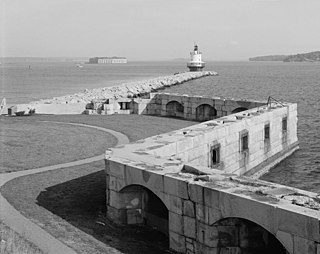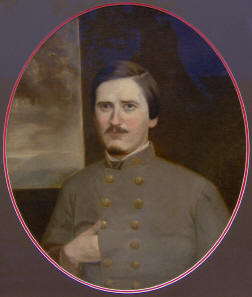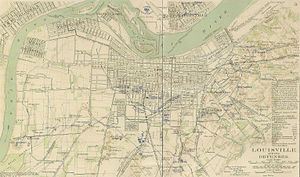
The Battle of Nashville was a two-day battle in the Franklin-Nashville Campaign that represented the end of large-scale fighting west of the coastal states in the American Civil War. It was fought at Nashville, Tennessee, on December 15–16, 1864, between the Confederate Army of Tennessee under Lieutenant General John Bell Hood and the Union Army of the Cumberland (AoC) under Major General George H. Thomas. In one of the largest victories achieved by the Union Army during the war, Thomas attacked and routed Hood's army, largely destroying it as an effective fighting force.

Fort Worden Historical State Park is located in Port Townsend, Washington, on 433 acres originally known as Fort Worden, a United States Army Coast Artillery Corps base constructed to protect Puget Sound from invasion by sea. Fort Worden was named after U.S. Navy Rear Admiral John Lorimer Worden, commander of USS Monitor during the famous Battle of Hampton Roads during the American Civil War.

Fort Preble was a military fort in South Portland, Maine, United States, built in 1808 and progressively added to through 1906. The fort was active during all major wars from the War of 1812 through World War II. The fort was deactivated in 1950. It is now on the campus of Southern Maine Community College.
The Orphan Brigade was the nickname of the First Kentucky Brigade, a group of military units recruited from Kentucky to fight for the Confederate States of America during the American Civil War. The brigade was the largest Confederate unit to be recruited from Kentucky during the war. Its original commander was John C. Breckinridge, former United States vice president, and Kentucky's former senator, who was enormously popular with Kentuckians.

Louisville in the American Civil War was a major stronghold of Union forces, which kept Kentucky firmly in the Union. It was the center of planning, supplies, recruiting and transportation for numerous campaigns, especially in the Western Theater. By the end of the war, Louisville had not been attacked once, although skirmishes and battles, including the battles of Perryville and Corydon, Indiana, took place nearby.

The Defense of Cincinnati occurred during what is now referred to as the Confederate Heartland Offensive or Kentucky Campaign of the American Civil War, from September 1 through September 13, 1862. Confederate Brigadier General Henry Heth was sent north from Lexington, Kentucky, to threaten Cincinnati, Ohio, then the sixth-largest city in the United States. Heth was under orders from his superior, Major General Edmund Kirby Smith, not to attack the city, but to instead make a "demonstration". Once Heth arrived and reconnoitered the defenses, he realized an attack was pointless. After a few minor skirmishes, he took his men back to Lexington.

The 104th Ohio Infantry Regiment, sometimes 104th Ohio Volunteer Infantry, was an infantry regiment in the Union army during the American Civil War. It played a conspicuous role at the Battle of Franklin during the 1864 Franklin–Nashville campaign, where six members later received the Medal of Honor, most for capturing enemy flags.

Quincy Adams Gillmore was an American civil engineer, author, and a general in the Union Army during the American Civil War. He was noted for his actions in the Union victory at Fort Pulaski, where his modern rifled artillery readily pounded the fort's exterior stone walls, an action that essentially rendered stone fortifications obsolete. He earned an international reputation as an organizer of siege operations and helped revolutionize the use of naval gunnery.

Graves' Artillery Battery, also known as [Kentucky] Issaquena Artillery Battery, was organized as a Confederate States Army artillery battery from Mississippi and Kentucky on November 8, 1861. During its formation, as a still understrength battery, the first commander was Captain Selden Spencer. In December, at Bowling Green, Kentucky, then Confederate Army Brigadier General (CSA) John C. Breckinridge chose Captain Rice E. Graves, Jr., as captain of the new battery to be attached to the 2nd Kentucky Infantry Regiment and assigned to his division. The unit was first assigned to Reserve, 1st Geographical Division, Department #2. Then the regiment was assigned to the Kentucky Brigade, Army of Middle Tennessee, Department #2 in October–November 1862. In November 1862, the regiment was assigned to the Kentucky Brigade, Breckinridge's Division, 1st Corps, Army of Tennessee in November 1862, nicknamed the "Orphan Brigade".
The 5th Kentucky Infantry Regiment, unofficially known as the Louisville Legion was an infantry regiment that served in the Union Army during the American Civil War.
5th Indiana Battery Light Artillery was an artillery battery that served in the Union Army during the American Civil War. It was often referred to as Simonson's Battery.
7th Indiana Battery Light Artillery was an artillery battery that served in the Union Army during the American Civil War.
Independent Battery "B", Pennsylvania Volunteers was a light artillery battery that served in the Union Army during the American Civil War. The unit was also referenced as the Twenty-sixth Independent Battery, Pennsylvania Artillery, and commonly as "Muehler's Battery," or "Stevens' Battery," after its first two commanders.
Battery C, 1st Ohio Light Artillery was an artillery battery that served in the Union Army during the American Civil War.
Battery A, 1st Ohio Light Artillery was an artillery battery that served in the Union Army during the American Civil War.
17th Ohio Battery was an artillery battery that served in the Union Army during the American Civil War.
15th Indiana Battery Light Artillery was an artillery battery that served in the Union Army during the American Civil War.
The 22nd Indiana Battery Light Artillery was an artillery battery that served in the Union Army during the American Civil War.
23rd Indiana Battery Light Artillery was an artillery battery that served in the Union Army during the American Civil War.

Henshaw's Battery Illinois Light Artillery was an artillery battery from Illinois that served in the Union Army during the American Civil War. The battery was mustered into service in December 1862 and assigned to guard duty in Kentucky. In July 1863, the battery helped capture John Hunt Morgan's raiders at Buffington Island and Salineville. Beginning in August 1863, the unit took part in Ambrose Burnside's campaign in East Tennessee and the Knoxville campaign. It spent the rest of the war on garrison in east Tennessee before being mustered out of service in July 1865.










